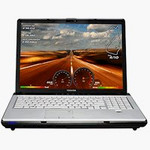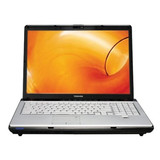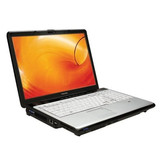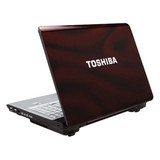Toshiba Satellite X205-SLi3
Especificaciones de Portátil(es)

Price comparison
Promedio de 1 puntuaciones (de 2 análisis)
Análisis para el Toshiba Satellite X205-SLi3
Origen: Notebookreview.com
 EN→ES Archive.org version
EN→ES Archive.org versionOverall, the effectiveness of SLI technology is hit or miss. While it has plenty of potential as seen in Quake Wars: Enemy Territory and 3DMark06, the difference simply does not add up on the whole. One-third of the games I tested did not show any gain from enabling SLI and from those that did, only one showed a performance increase matching what Nvidia claims is possible (2X). Other games showed at best a 60 to 70% improvement (which is still impressive). The point is, do not expect an SLI gaming setup to literally double framerates. As I stated at the beginning of the article, Toshiba sells two series of the X205 gaming notebook; one has a single 8700M-GT card and the other series, tested here, has dual 8600M-GTs. A single 8700M-GT is 30 to 40% faster than a single 8600M-GT on average.
Leistung zufriedenstellend
Análisis del Usuario, disponible online, Mediano, Fecha: 12/04/2007
rendimiento: 70%
Origen: CNet
 EN→ES Archive.org version
EN→ES Archive.org versionThe current flood of excellent gaming laptops (Dell's XPS M1730, HP/Voodoo's Envy, and Alienware's m9750) means that PC gamers have plenty of choices when it comes to picking a new mobile rig. To break through the clutter, Toshiba, not exactly the first name that comes to mind when you think of gaming, would have to offer something special. By putting dual SLI Nvidia GeForce 8600M GPUs in its standard 17-inch Satellite chassis for as little as $1,999, the company has done just that. Our slightly upgraded Satellite X205-SLi3 cost a little more at $2,499, but that's still a few hundred dollars less than the cheapest SLI configurations from Alienware or Dell (although they start with the higher-end Nvidia 8700).
7.7 von 10, Preis/Leistung gut, Leistung gut, Mobilität mangelhaft, Display mangelhaft
Único Análisis, disponible online, Mediano, Fecha: 11/20/2007
Puntuación: Puntuación total: 77% precio: 80% rendimiento: 80% pantalla: 50% movilidad: 50%
Comentario
NVIDIA GeForce 8600M GT: NVIDIA GeForce 8600M GT es la sucesora directa DirectX 10 de la GeForce Go 7600 GT para portátiles. Dependiendo de la memoria grafica utilizada y la velocidad de frecuencia, el rendimiento está entre las tarjetas de video 7600 GT y 7900 GS. Por lo tanto, juegos actuales como Company of Heroes, Supreme Commander, o F.E.A.R pueden ser jugados fluidamente con altos detalles en una resolución de 1024 o similar. Jugadores, que cada vez esperan frame rates supremos, deberán esperar las serie 8800 de NVidia.
Estos procesadores gráficos pueden mostrar únicamente juegos antiguos, fluidamente. Juegos actuales pueden ser presentados con detalles sustancialmente reducidos.
>> Más información puede ser encontrada en nuestra comparación de tarjetas gráficas moviles y la lista de benchmarks.
Intel Core 2 Duo: Este es el sucesor Core Duo y el Core Solo con un pipeline más largo y con una velocidad entre 5-20% sin mayor consumo de energía. Adicional al diseño de Core Duo existe un cuarto decodificador, una unidad SSE ampliada y una unidad lógica aritmética (ALU) adicional.
Sus características son: 2 núcleos (cores), una amplificación de comando de 64-bit EM64T y 2 o 4 MB L2 Cache y 291 millones de transistores, que son acabados en 65nm. Mas allá de esto, todos los tipos soportan técnicas "Execute Disable Bit", SSSE3 (SSE4), Enhanced Speedstep, LaGrande y la mayoría de técnicas de virtualizacion (VT) Vanderpool.
El Core 2 Duo para laptops es idéntico a los procesadores Core 2 Duo para desktops, pero los procesadores para notebooks trabajan con tensiones más bajas (0.95 a 1188 Volt) y un Frontside bus clock (1066 contra 667 MHz). El rendimiento de laptops cuena con una frecuencia de 20-25% más baja que PCs Desktop debido a una frecuencia más baja de Frontside bus y los discos duros más lentos.
T7500: El Core 2 Duo T7500 es un Core 2 Duo basado en arquitectura Merom con 4 MB de Cache de nivel 2. Se situa en la gama media (en 2009) y rinde a la par que los modernos P7550 o Turion II Ultra M640/M660.
>> Más información puede ser encontrada en nuestra comparación de procesadores móviles.








